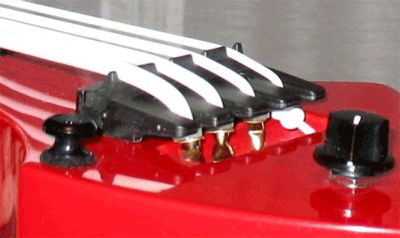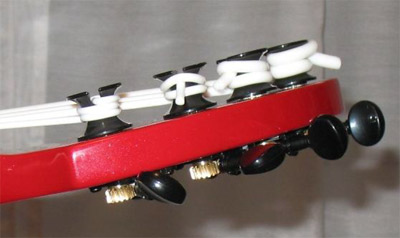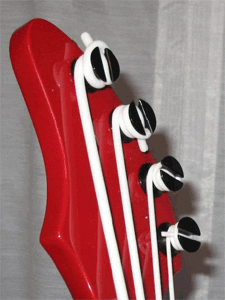Using Aquila Thundergut Bass Ukulele / Ashbory Bass Strings as an Alternative to Silicone Rubber Strings
Contributed by Mark Muretisch on April 4, 2013
Before purchasing my Ashbory bass I was well aware of its problems that years of others' experience had revealed. But making one simple modification to resolve the most significant issue could transform it into a more reliable instrument, particularly for the performing musician.

The Problem(s)



The biggest criticisms I've heard and read about from players of the Ashbory bass are regarding the silicone rubber strings:
- They are very elastic and take a long time to stabilize and stay in tune.
- They feel sticky and many players use talcum or other powder on the hands for improved playability and less string noise.
- They break easily and unexpectedly, particularly the D and G-strings which have the most tension. It had been reported that these strings will actually break while the instrument is not even in use!
A related problem is the E-string popping out of the nut slot during play. The most common remedy is to reverse-wind the string on the tuning peg to reduce the lateral angle of the string between the nut and tuning peg (for more direct string pull). Another known remedy is to put an inexpensive elastic-cloth capo over the strings above the nut.
Finally (an aesthetic concern for me), large knots at both ends of each string and extra string material commonly left untrimmed beyond the knot at the tuning machine end (to "save" the string should it break at the bridge) are unsightly, detracting from the instrument's otherwise clean appearance.
The Solution
The recent advent of Aquila Thundergut Bass Ukulele / Ashbory Bass strings (Set #68U) offers a more reliable and better performance alternative for the Ashbory bass.
According to the manufacturer, the composition of these strings is a "special very dense and elastic-plastic blend...". These strings are harder and stiffer than silicone, and their surface is not particularly sticky. They tune with less winding and stabilize quickly, and require no pre-stretching. They offer a solid feel and tighter response than silicone strings. Although some may miss the "silicone sound", the tonal qualities are excellent, in my opinion. I immediately prefered the Aquila's for the broad style of play and sound I was ultimately looking for.
Installation Notes
Bridge Ends
The bridge ends of the three heaviest strings are metal-banded and crimped. All have plastic washers to hold them firmly against the bridge slot.
Tuning Machine Ends
The tuning machine ends are plain, but the usual unsightly knots are no longer required, but instead the strings can be looped and wound more like regular bass strings. Forget about leaving untrimmed string material hanging as it is no longer necessary. These stiffer strings should wear longer and be less likely to break as often.
The stiffer strings will also roll less, so the E-string is not as likely to pop out of the nut slot when wound normally.
Tuning Machine Attachment
My particular method of attachment to the tuning machines is similar to how I typically string a guitar or bass - the end across the slot, then one loop over, and the rest under. This will hold the strings tightly without any slippage over time. With much less stretch in the material, the strings will tune much quicker than silicone -- and stay in tune.
Conclusion
I believe that the Aquila Bass Ukulele / Ashbory Bass strings may actually breathe new life into the Ashbory Bass, by eliminating the pitfalls of silicone strings. The Aquila strings sound great, too. Over time, I expect they will prove to be far more reliable, making the Ashbory bass a practical choice for the serious, performing musician.
